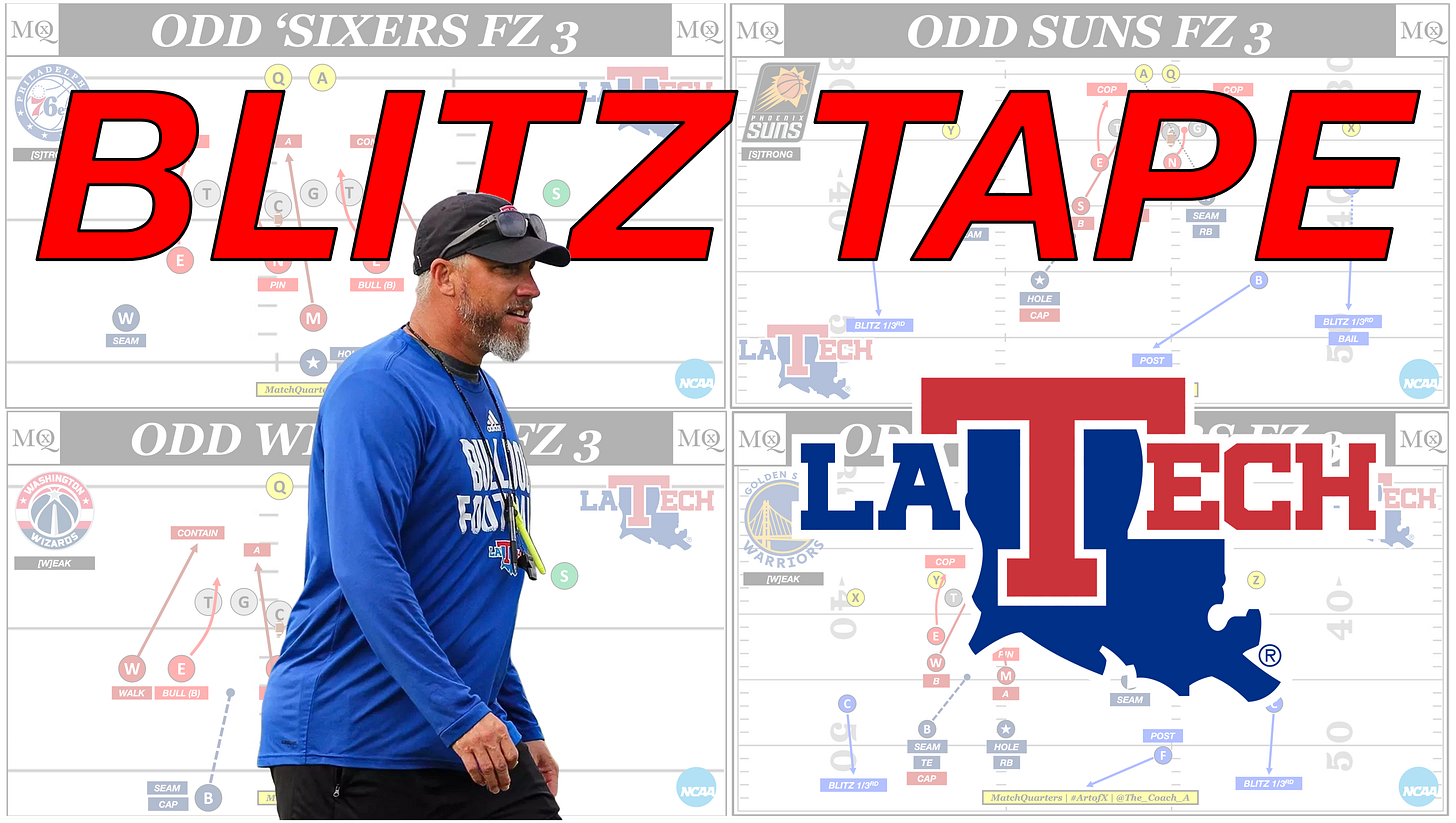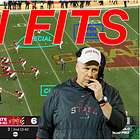Louisiana Tech Blitz Cut-Up (2024)
Introducing the Bulldogs' Occam's Razor defense. Sometimes, simple is best.
Louisiana Tech went 5-8 last year, losing five of those games by one score or less. Three of the Bulldogs’ losses came in overtime. Three losses came by more than one score (seven points): to North Carolina State, Arkansas, and in their bowl game against Army. In a majority of their games, the defense wasn’t the issue.
Defensively, the LA Tech had one of the better units in Conference USA. Under the tutelage of Jeremiah Johnson, the Bulldogs’ defense was a stabilizing force all year. Due to its schedule strength, the LA Tech defense can be overlooked when evaluating weighted metrics. BCF Toys DFEI (think FTN’s DVOA for the NFL) had the unit finishing 86th overall.
But if you dig a little deeper and look at some of the unadjusted efficiency ratings, you find one of the better defenses in the country. The Bulldogs were 25th in Points Per Drive (PPD), 18th in Yards Per Play, 16th in 1st Down Rate (drives that at least gain ten yards), and 12th in TD/FG rate.
Overall, LA Tech only surrendered an average of 21 points per game, which was 26th-best in the country. The Bulldogs were 12th in total defense, surrendering an average of 308 yards per game. They were also sixth in passing yards per game (173).
Sure, most of the offenses in the CUSA weren’t great. Six teams, including LA Tech, can be found at the very bottom of the BCF Toys OFEI ratings. Still, the Bulldogs’ defense was one of the best in the country last year, and illustrated that doing simple concepts very well can have a devastating effect on opponents.
Jeremiah Johnson hails from Northern Iowa, where he spent 15 years as a coach, most of them as the team’s defensive coordinator. The Panthers play in the Missouri Valley Conference, which is the SEC of the FCS. North Dakota State, South Dakota State, and Northern Iowa have been mainstays within the FCS playoffs.
In 2023, Johnson made the jump to the FBS, working one (mostly forgettable) year at Kent State and then taking over the reins in Ruston under Head Coach Sonny Cumbie. Johnson is now tasked with leading the Coastal Carolina defense after Craig Naivar left to be the Special Teams Coordinator (STC) for Arizona.
Johnson’s defense in Ruston was his brand of an Odd Stack defense. The Three-High defensive revolution remains strong at the G5 level due to sufficient recruiting of ‘tweener athletes’ left over by the power conferences. Going back to ‘22 for Northern Iowa, Johnson had been playing an Odd Stack. Last year, the front was mostly an Odd or 505 alignment that utilized the three ‘stacked’ linebackers to fill the gaps.
For the most part, the DEs did not crash or ‘splatter’ (Iowa State = Fist) the B-gaps utilizing a Heavy Technique that is familiar to most Odd Stack teams. The Middle Safety was also less aggressive than most Three-High defenses that require him to be ‘in the fit’ on most downs. Johnson used the Middle Safety as more of a ‘cap’ fitter and High Hole defender than a typical 3-Fit that, say, Iowa State would use.
Coverage Profile
—
The Bulldogs in ‘24 ran mostly Quarters and Cover 3, with Tampa iterations mixed in, typically with a ‘trap’ or ‘hard’ CB in the outside flat. The three linebackers attached to the box were mainly used as underneath players. The Bulldogs were sixth in middle-of-the-field open (MOFO) coverage usage.
Johnson’s defense was designed to pack the middle of the field with defenders and force throws outside to the perimeter. The low outside throws (Curls/Hitches) that teams consistently hit was one ‘soft’ area that consistently showed up on tape. Still, most of those had to go from the hash to the field sideline, making them long enough for the defense to typically rally to the ball. Again, this defense excelled against the pass.
The split-field usage and stacked box funneled the ball into low-percentage areas. The further outside and deeper the ball goes, the less likely the offense is to complete it. With CBs backed off and on top of receivers, the Bulldogs were able to cap verticals, limiting explosive plays, and rally to the ball underneath.
That isn’t a way modern college offenses want to throw the ball. Most want the big, sexy, deep choice routes. Johnson devised a way to compress the field and force teams to run the ball, which is the modern version of the bend-don’t-break defensive philosophy. In CUSA, with bad quarterback play all around, the Bulldogs forced offenses to be precise and patient, which many couldn’t afford.
Blitz Profile
—
Keep reading with a 7-day free trial
Subscribe to MatchQuarters by Cody Alexander to keep reading this post and get 7 days of free access to the full post archives.







